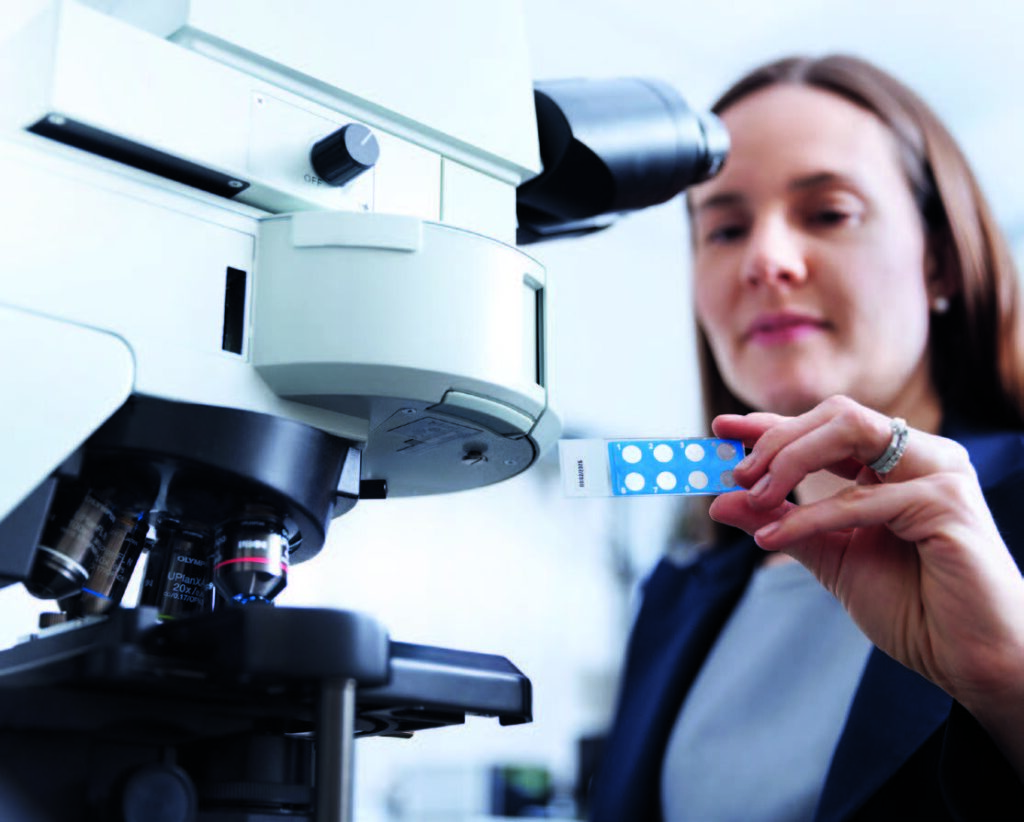A NEED TO KNOW: Stephanie Syc-Mazurek, M.D., Ph.D., wants to answer questions for her patients
Meet the 2025 recipient of the Mayo Clinic Alumni Association Donald C. Balfour Award for Meritorious Research.
Stephanie Syc-Mazurek, M.D., Ph.D.
Clinical fellow in autoimmune neurology
Mayo Clinic in Minnesota
Residency: Neurology, Mayo Clinic School of Graduate Medical Education, Rochester, Minnesota
Postgraduate: M.S. and Ph.D., neuroscience, University of Rochester, Rochester, New York
Medical school: University of Rochester, Rochester, New York
Undergraduate: Brown University, Providence, Rhode Island
Hometown: Lake Forest, Illinois

Stephanie Syc-Mazurek, M.D., Ph.D. (I ’21, N ’24, NAI ’25), has always been curious.
“Even in elementary school and high school, finding out why things happen was always important to me,” she says.
As a kid, her curiosity and creativity were focused on subjects like poetry and creative writing. Today, she wants to know why and how people develop autoimmune neurologic diseases, particularly those affecting the eye — and how they could be treated.
“We don’t have cures for a lot of these diseases that affect the eye and the immune system,” Dr. Syc-Mazurek says. “So much has come to be known over the last years and decades, but pushing things forward certainly is motivating.”
The answers are not just for her own benefit; she is deeply passionate about using research and expertise to answer her patients’ most pressing questions about the course of their disease, their projected quality of life and the hope for cures.
“Clinically, she has an incredibly deep knowledge base and pairs that with the warmest bedside manner, where she translates complex situations in an understandable and calming way,” says Elizabeth Coon, M.D. (I1 ’10, N ’13, MD ’14), Division of Autonomic Disorders at Mayo Clinic in Minnesota. “She has potential to transform the field of neurology as an exceptional clinician, scientist, educator and leader.”
Dr. Syc-Mazurek is a clinical fellow in autoimmune neurology at Mayo Clinic in Minnesota and is affiliated with Mayo Clinic’s Center for Multiple Sclerosis and Autoimmune Neurology. She will start the Neuro- Ophthalmology Fellowship at Mayo Clinic in 2025. She is the 2025 recipient of the Mayo Clinic Alumni Association Donald C. Balfour Award for Meritorious Research.
“It’s just an honor to care for people both here in our community and around the world — and also have the opportunity through research to try to make an impact beyond our walls,” says Dr. Syc-Mazurek.
ASKING QUESTIONS
As an undergraduate studying neuroscience, Dr. Syc-Mazurek’s curiosity was focused on the brain: Why do humans think the way they do? How does the brain impact human behavior?
After graduating, she worked as a research coordinator under the mentorship of Peter Calabresi, M.D., a multiple sclerosis expert at the Johns Hopkins University School of Medicine, as he conducted imaging research and clinical trials in patients with neuroinflammatory diseases.
She was trying to decide whether her next step should be medical school or graduate school. In Dr. Calabresi’s lab, she started to appreciate the power of research to not only improve patient outcomes and satisfy her own relentless curiosity, but to answer patients’ toughest questions.
“We can use research to advance what we can do for patients and give them answers to questions like, ‘What will my life look like in 10, 20 or 30 years?’” she says. “I think that combination was really what made me fall in love with medicine and decide to do the M.D.-Ph.D. dual degree.”
The debate between a research and clinical career was settled: she would do both. But she was slightly nervous about entering a doctoral program, as her prior research efforts had all been patient-centered and clinically focused.
“Going into the Ph.D., I had never completed an independent basic science research project,” she says. “But knowing the strength that the lab and translational research brings for answering those questions that our patients want to know — I wanted to learn how to do that. So I took the leap.”
During her Ph.D. program in the lab of Richard Libby, Ph.D., at the University of Rochester in New York, she studied the molecular mechanisms of cell death in the eye. She identified key molecules that govern cell death in the retina and degeneration in the optic nerve using animal models and thereby identified future potential therapeutic targets to prevent vision loss. After completing her doctoral degree, she was interested in studying the immunology of the eye and how it could inform other neurologic diseases. She also knew she wanted a translational science career in neurology with a focus on imaging modalities. When she came to Mayo Clinic for her interview on a cold January day, she found what she was looking for.
“The idea that the needs of the patient come first really spoke to me,” she says, and a conversation with Lyell Jones Jr., M.D. (I1 ’01, N ’04, NEMG ’05), Department of Neurology at Mayo Clinic in Minnesota and current dean of Mayo Clinic School of Graduate Medical Education, solidified her good impression.
“I remember Dr. Jones saying, ‘We’re here to develop leaders in neurology and whatever that means to you is what’s important for us. We’re invested in you from step one,’” she says.
Dr. Syc-Mazurek has certainly developed into a leader of neurology, and her time at Mayo Clinic has been prolific. She has published 13 peer-reviewed articles since arriving at Mayo Clinic, with eight as first or second author. She has first-author publications in top-tier neurology journals including Brain, Neurology, Neurology Neuroimmunology & Neuroinflammation, and Stroke. Altogether, she has published over 50 abstracts and 33 peer-reviewed publications with over 2,500 citations. She is also on the editorial board of Neurology’s Resident & Fellow Section, a highly selective position within the American Academy of Neurology.
She says she’s grateful for her clinical and research mentors — particularly Eoin Flanagan, M.B., B.Ch. (I1 ’09, N ’12, NMS ’13, NAI ’14, NBN ’15, CTSA ’16), chair of the Division of Multiple Sclerosis and Autoimmune Neurology at Mayo Clinic in Minnesota, and John Chen, M.D., Ph.D. (OPH ’14), Department of Ophthalmology at Mayo Clinic in Minnesota — for their support and for the opportunity to participate in research projects, as well as Dr. Jones and Dr. Coon for leadership opportunities within the residency program.

DIFFERENTIATING DISEASE
Dr. Syc-Mazurek’s work has focused on utilizing imaging metrics to characterize a nervous system demyelinating disease known as myelin oligodendrocyte glycoprotein anti- body-associated disease (MOGAD). She has helped differentiate MOGAD from its major mimic, multiple sclerosis (MS).
A prime example: Dr. Syc-Mazurek was first author of an article published in Neurology that found that patients with MOGAD rarely develop asymp- tomatic lesions as seen on MRI, a marked contrast to MS.
“This result was paradigm-shifting, as it suggests that regular MRI surveillance outside of clinical attacks in MOGAD is unnecessary, differing majorly from multiple sclerosis where this is standard of care, with important cost savings for MOGAD patients and the healthcare system,” says Dr. Flanagan.
This research also indicated that MRI metrics are not ideal biomarkers of disease activity in MOGAD, which had implications for ongoing clinical trials. Another study identified the MRI characteristics that differentiate patients with MOGAD from MS at the time of clinical attack and remission.
Dr. Syc-Mazurek’s other research of note includes evaluation of optic nerve changes during acute optic neuritis, defining the clinical presentation and etiologies of optic perineuritis, and a novel case presentation of a patient with MOGAD and metastatic melanoma. Her studies offer valuable insights into the underlying pathophysiology of MOGAD with the promise of identifying potential biomarkers for disease progression and targets for therapeutic intervention.
SMALL VICTORIES
Looking to the coming years, Dr. Syc-Mazurek is excited to put together the clinical and translational aspects of her research and utilize the skills she’s accumulated over the past decade. She hopes to do more work at the intersection of the immune and visual systems in MOGAD and similar diseases. And of course, she has more questions to answer.
“Can we better differentiate these diseases earlier? Can we figure out better ways of predicting disease outcomes? Can we come up with better ways of intervening from a molecular mechanism?” she says. “There’s so much to learn. How can we better help our patients from a disease-therapy standpoint? How can we better educate them?”
Knowing that these questions will take years — or perhaps decades — to answer, Dr. Syc-Mazurek uses small moments to stay on track.
“It’s really motivating to help someone who was hospitalized to get back to doing something that they love,” she says. “It’s taking those small victories, whether it’s the small victory you find in the dataset or the small victory in the lab with what you see in a slide — or, most importantly, the small victory in the patient.”
Read about the 2025 Kendall Awardee here.
Illustration by Ameesha Lee.